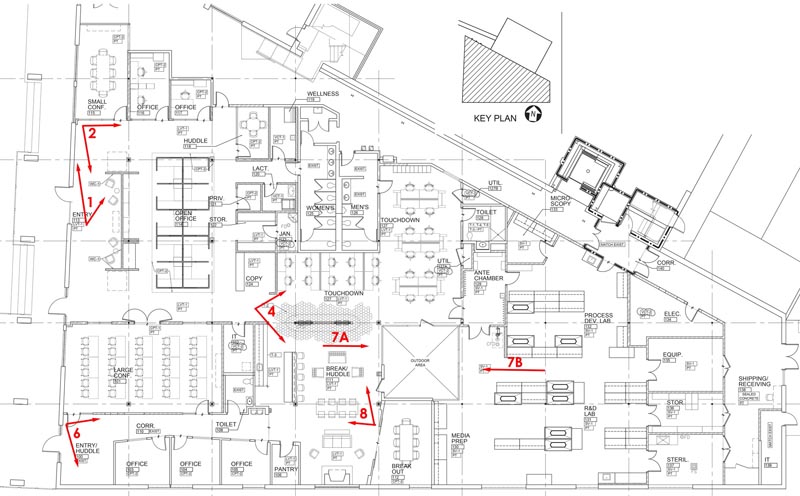A question I’m often asked by potential clients is “How do I work?” to which I typically answer, “Well what are you looking for?” At first glance it may seem a generic response but having been in business for 9 years, collaborating with over 150 clients in 15 states, ranging from multinational companies to one-person shops, I’ve quickly learned to become flexible and mold to individual need. This flexibility encompasses photographic technique, staging, lighting, incorporating people, very similar to the way an architect does for his or her client. I’ve been hired to capture award-winning projects and protypical fast-food chains. Some architects know the exact vision they have in mind for their photography and it’s essentially paint-by-numbers. On the opposite side of the spectrum, some clients are brand-new to the idea of photography and don’t know what they’re looking for or what they may entail and you must guide them hand-in-hand. However it’s usually somewhere in between: the architect knows what design ideas they’d like to convey, specific elements they’d like to market and the final results is a blend of their expertise, detail, and knowledge from working on a project for months or years, with the fresh eye, design insight, talent and capability a photographer brings to the table. Sometimes you just take the pre-determined shots and other times opportunities are revealed on location, such as under the orange staircase at Parmer RTP
Architectural photography, just like architecture itself, is a design process. My utmost concern is to do an outstanding job for whatever crosses my plate, whether it’s an airport terminal or gas station and will always go all out to do so.
I’ve had the pleasure working with Integrated Design for the past several years, beginning with a parking deck. Since then they’ve been kind to entrust me with a variety of projects, the latest the interior office space of Precision Biosciences in Durham, North Carolina. Just like my former architectural career, when it comes to photography, I’m a huge preparation wonk*. Whether the project is in Dallas or my backyard, it’s my business to know everything possible to know about the assignment before getting started. For Precision Biosciences, this began in the form of floor plans, followed by a local site visit. Integrated had a general sense of how many photos they’d like but hadn’t pin-pointed exact views. Upon my visit, I knew from the jump there’d be challenging interior light situations so I snapped some quick views and mapped them out to run past the architects.
*and yet you’ll constantly yourself in scenarios that require quick decision-making on the fly!

Again some architects like to map out views, but here Integrated was comfortable with me proposing the shots.

To get started, this was the lowest priority photograph on the entire list, likely because this location was already captured by another photographer. However, I had a vision of how the space could be presented so kinda overrode the architect on this one. 😉 It’s a simple shot and materials are nothing but concrete and drywall, but the photo illustrates the care and thought the designer put into the office that may not be as obvious in 2D floor plans.


There is a ton of program between open offices, bullpens, meeting areas, and yes – a phone booth/TARDIS from Doctor Who.


As earlier described, architectural photographers design photographs and we will move and re-arrange to present a space in it’s best light while staying true to the design. Obviously between scoping out the space and the shoot, the blue partition was painted white.


This division wall created a couple opportunities for shots. I did capture a different view showing the split with the open office, however with this photograph wanted to simplify the focus to the how it relates to the outside mini-courtyard. Not only were furniture decisions were made, but answering questions such as “Does that suspended light really need to be in THIS picture?” resulting in a shift of the photo frame.


People add scale, life, and context, but also make for nifty design solutions. The first decision that had to be made, however, was lighting. This was a 3-light shot. As you can tell, the color temperature of the green wall lights differ from all the other lights in the scene, so we fixed that while on location in order for them to all visually match.

My job is to simplify design for the viewer’s eye. From this reception area, you get a good view of the green wall in the corridor as well as the meeting room. However the water-fountain, as you can tell from the snapshot above, features prominently. Instead of fighting against the fountain, I chose to work with it, placing a person there.

Scoping like this also enables the architect to tell me things like, “Hey yeah – make sure we turn that green backlight off.”


I really liked this office view while scoping and fortunately Integrated did as well. Strategically place three lights with a couple of co-workers and presto.


Finally, is a shot featuring the green wall from inside some office space.

That’s right, I used an employee rushing in to the use the restroom – I’ll do it again.
That’s it for now. I’ll get into how the process may differ with other projects later this year!





